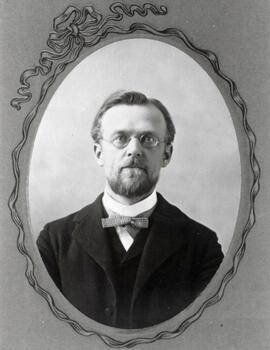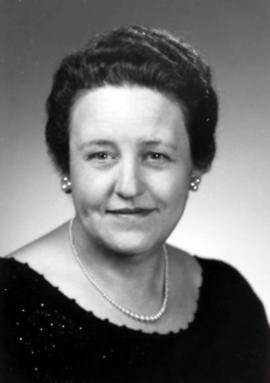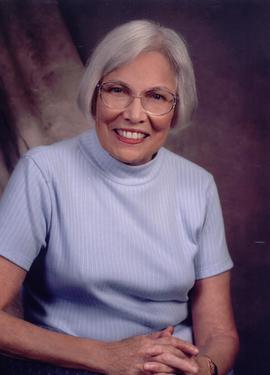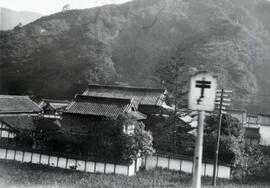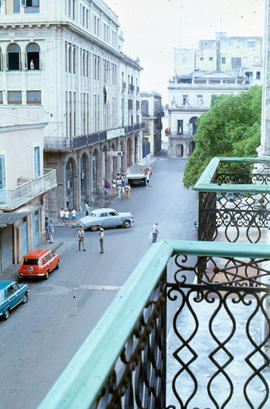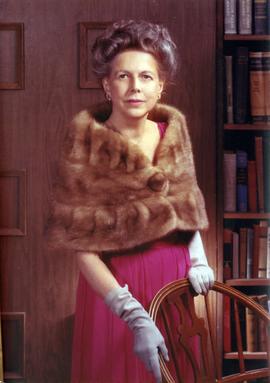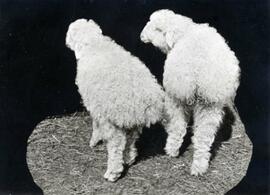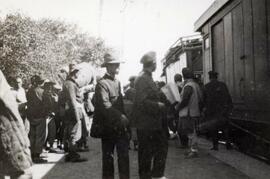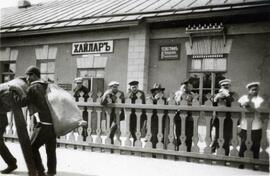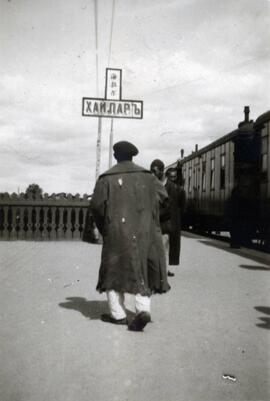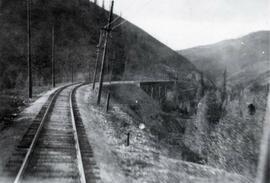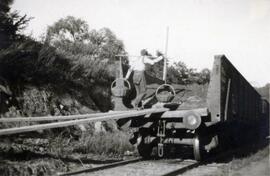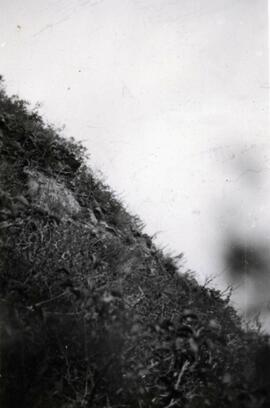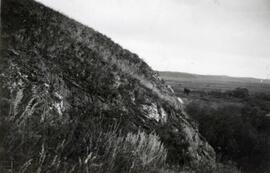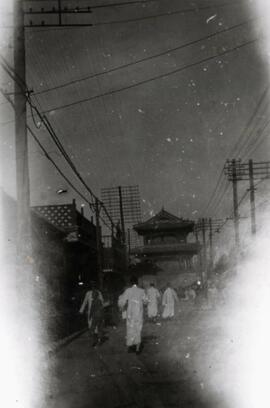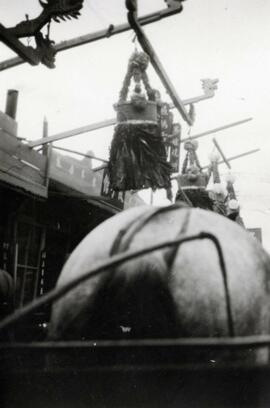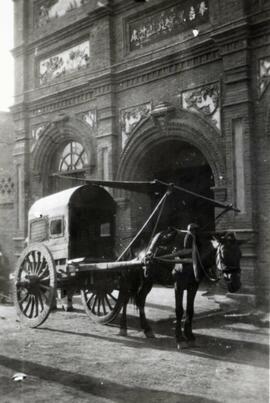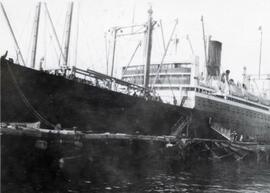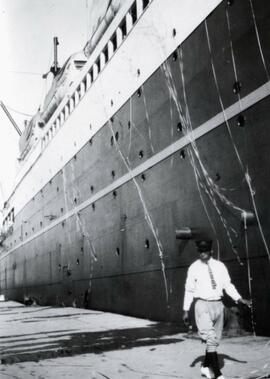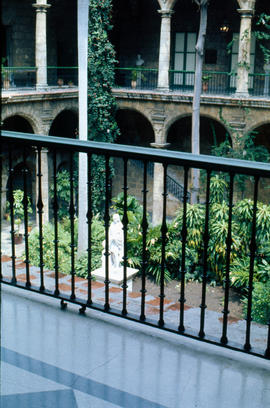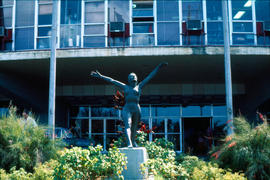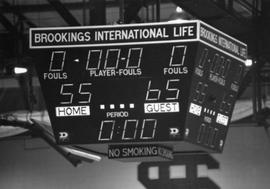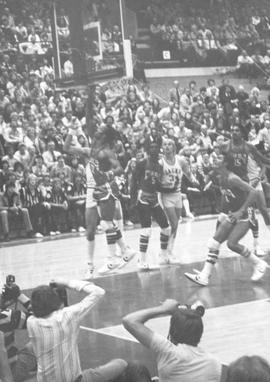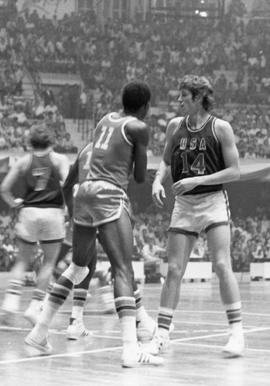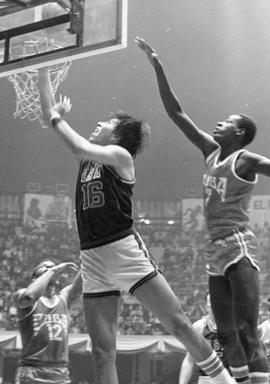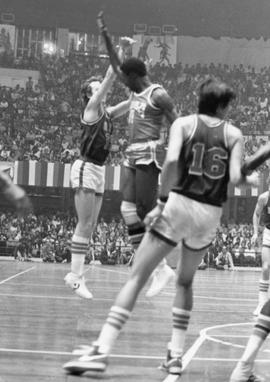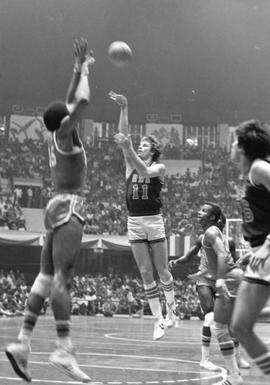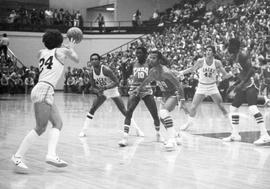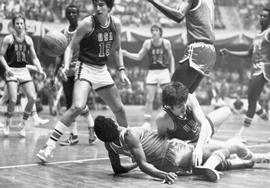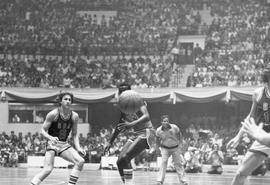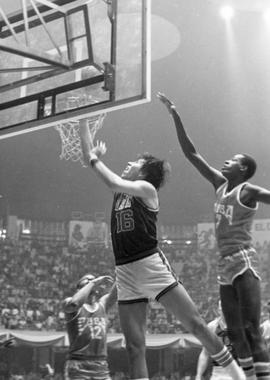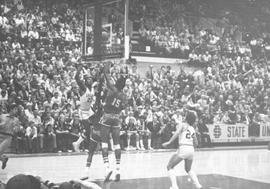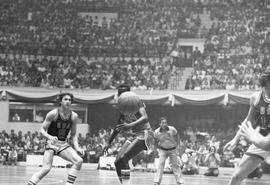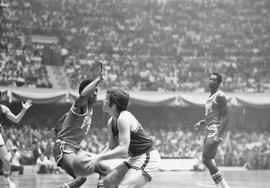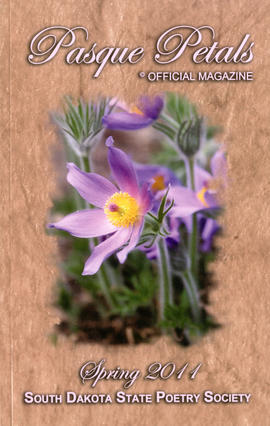Portrait of a young N.E. Hansen wearing a bow tie and a dark jacket
The Women Artists in Collaboration Records document the activities and creative work of the group, primarily through materials collected by co-founder Marilyn Richardson. The collection consists of correspondence (1986-1990), financial records (1987-1990), and project materials (1985-1989), which provide insight into the group's operations and artistic collaborations. The project records are particularly significant as they detail performance concepts and the collaborative process.
Additionally, the collection includes clippings, guest books (1987), meeting records (1986-1987), member biographies, and programs, offering context on the group's membership and events. Two scrapbooks (1985-1987, 1988) contain photographs and memorabilia, documenting performances, and the group's artistic impact. This collection highlights the group's creative contributions and organizational history.
Women Artists in CollaborationThis collection centers on Dr. Gibbons’ research into developing fuels and chemicals from biomass as sustainable replacements for petroleum-based products. It includes extensive materials documenting the feasibility, economics, and technology of ethanol production using agricultural feedstocks such as fodder beets, corn, and sweet sorghum. The bulk of the collection comprises article reprints, manuscripts, correspondence, and other materials related to scholarly articles submitted by Dr. Gibbons to academic journals.
The collection also contains draft manuscripts of Dr. Gibbons’ M.S. thesis and Ph.D. dissertation, which delve into the technological and economic aspects of ethanol production and its byproducts. Photographs and slides depict ethanol and fermentation plants, research equipment, and experimental setups, providing visual documentation of research findings and production processes. Aca-demic presentations, posters, and conference materials highlight the dissemination of research at scientific gatherings.
Additionally, the collection includes clippings from newspapers and magazines about ethanol and its production, spanning several decades. These articles reflect public perception and media coverage of renewable energy topics. Draft testimonies, handwritten notes, flowcharts, and tables offer insights into Dr. Gibbons’ advocacy efforts, including support for ethanol tax incentives and policies promoting renewable energy.
Notable topics include small- and farm-scale ethanol production, solid-phase and diffusion fermenta-tion techniques, the use of agricultural waste for mushroom cultivation, and the energy and economic feasibility of renewable fuel development. Mushroom cultivation research in the collection explores innovative applications of agricultural byproducts, while international travel documentation provides a global perspective on ethanol production practices.
Gibbons, William Ray 1958-photograph of Carrie Ingalls school class
This collection is composed mainly of slides and photographs related to Gardner's research on virus diseases of plants, with a focus on wheat streak mosaic virus and tobacco mosaic virus. Also included is material related to crop injuries related to the environment and air pollution. Other material included publications related to his research.
Gardner, Wayne S.The W. Carter Johnson Papers present a comprehensive account of ecological research spanning varying ecosystems and geographical regions, organized into distinct series.
The Blue Jays series delves into the behavioral patterns of blue jays, focusing on caching and consumption behaviors related to acorns. Through meticulous field studies, Johnson examines how blue jays manage acorn tannins, cope with weevil-infested nuts, and contribute to forest regeneration through seed dispersal, highlighting their vital role in shaping forest ecosystems.
In the Forests/Trees series, the focus broadens to encompass broader forest ecosystems, emphasizing woodland restoration, forest succession, and management strategies. Various case studies within this series explore topics such as the impacts of natural disturbances like ice storms on forest dynamics, the effectiveness of restoration efforts in maintaining pine-oak forests, and the factors influencing tree recruitment in fragmented landscapes and riparian zones. Through detailed analyses and historical perspectives, researchers highlight the complexities of forest ecosystems and underscore the importance of ecological restoration for ensuring their long-term sustainability.
The Mortensen Ranch series offers a detailed account of land management and restoration efforts, documenting historical research, restoration projects, and visual progress through photographs and digital images, showcasing the ranch's commitment to sustainable practices. From regrowth of wooded draws to mitigation of flood impacts, the documents highlight the ranch's dedication to ecological balance and conservation excellence.
The Platte River series provides a comprehensive examination of the river's ecological, geological, and historical aspects, contributing valuable insights into its dynamics and ongoing conservation efforts. Spanning surveys, scientific research, professional activities, and historical records, this series offers foundational data on the river's islands and surrounding areas, investigating vegetation changes over time and informing management strategies for preserving its ecological integrity.
The Prairie Wetlands series focuses on wetland ecosystems within the North American prairie pothole region, addressing ecological, management, and conservation challenges posed by climate change. Studies provide insights into wetland structure and function, with a particular emphasis on specific sites and long-term dynamics, offering valuable resources for informing adaptive management strategies and conservation efforts.
The Snake River series covers extensive research and environmental studies conducted along the Snake River in Idaho, informing conservation efforts and sustainable management practices. From detailed reports on specific projects to field notes and vegetation sampling methods, this series offers a wealth of information on the river's ecosystem dynamics and management challenges.
The Rivers/Lakes series offers a wealth of research and data on various river and lake ecosystems, contributing to a deeper understanding of their dynamics and informing management strategies. Covering topics such as hydrology, vegetation, and wildlife, this series serves as a valuable resource for conservation and management efforts in aquatic ecosystems.
Material in the Russia series sheds light on scientific collaboration, research activities, and environmental initiatives in the Soviet Union, fostering international cooperation in ecological research. Key elements include correspondence detailing exchange visits, translations of scientific literature, and reports on Soviet ecology, enriching our understanding of Russian ecology and environmental science.
Beyond specific research topics, the collection also showcases the personal and professional contributions of Carter Johnson, underscoring his commitment to environmental stewardship and ecological preservation. Overall, the W. Carter Johnson Papers serve as a valuable resource for researchers, educators, and conservationists, providing a rich tapestry of ecological knowledge and environmental stewardship practices aimed at safeguarding natural heritage for future generations.
Johnson, W. CarterThis collection is composed of material from Volstorff's personal and professional life. Folders includes personal records retained during her tenure as Dean of Women, records from her work with campus organizations, planning documents, and personal information and correspondence. Also included are Volstorff's many speeches and writings, including research and drafts for her book, Winds of Change.
Volstorff, Vivian V. (Vivian Virginia), 1907-2002This collection is composed of material produced by the Visual Arts Department. Folders include programs, pamphlets, exhibition material, clippings and photographs. Some items of note include completed student projects for the Art History course and photographs of Ada B. Caldwell and Maud Goddard, early Art faculty at South Dakota State College. Also included is a scrapbook created by students belonging to the Delta Phi Delta Art Fraternity. This scrapbook consists of clippings, memorabilia and original artwork by members.
South Dakota State University. Department of Visual ArtsThe Virginia Driving Hawk Sneve Papers document the literary career, research, and advo-cacy of the acclaimed Lakota writer, educator, and historian. Spanning from the 1960s to the 2020s, the collection includes manuscripts, correspondence, research materials, and pub-lished works that reflect her dedication to Native American storytelling and cultural preservation. It offers a comprehensive look at her contributions to literature, education, and Indige-nous representation.
The Creative Writing series contains fiction and non-fiction works, including Completing the Circle, The Medicine Bag, Dancing Teepees, Standing Bear of the Ponca, and Sioux Women. Each work is accompanied by manuscripts, clippings, correspondence, research notes, print-er’s galleys, proofs, reviews, and scripts. Many manuscripts include editorial annotations and suggested revisions. The correspondence primarily consists of letters between Sneve and publishers, as well as heartfelt messages from schoolchildren, some with drawings, thanking her for her books and school visits. Research materials include notes, collected documents, and recorded interviews. A video adaptation of High Elk’s Treasure is also part of the collection.
The General series includes awards, speaking engagements, clippings, interviews, journals, and research materials. Correspondence features exchanges with publishing houses, Sena-tor Larry Pressler, and fellow writers such as Bob Karolevitz and Audrae Visser. Notably, the series contains an audio reel of an interview Sneve conducted with Harold Shunk, a Bureau of Indian Affairs superintendent. Other items include a 1901 class photograph and various teaching aids.
The Other Writings series highlights Sneve’s contributions beyond creative literature, includ-ing published articles, scripts for a South Dakota Public Radio series, Christian education re-sources for the Episcopal Church Center, newspaper editorials, studies for the Flandreau In-dian School, and a contribution to On the Wings of Peace, a compilation benefiting world peace organizations.
This collection serves as a significant resource for researchers, scholars, and educators stud-ying Indigenous literature, storytelling, and cultural history. It offers a valuable perspective on Native identity, advocacy, and representation, highlighting Sneve’s enduring impact on Native American literary and educational landscapes.
Sneve, Virginia Driving Hawk, 1933-Village nestled in the mountains by the Inland Sea in Japan; written in pencil on the back: Along Inland Sea, Japan 1924
View from a balcony in Havana, Cuba
This collection is composed of material published by the Veterinary Science Department. Folders contain reports, photographs, and booklets from conferences, symposiums and workshops sponsored by the Department of Veterinary Science at South Dakota State University and the Cooperative Extension Service. Some materials produced by the Veterinary Science are distinctly marked as published by the Cooperative Extension Service. The photographs consist of images of diseases cows, horses, poultry, swine, rats, and dogs in various stages of selenium or alkali poisoning. Also included are photographs of faculty (specifically Moxon, Olson, and Franke), students, and various geographic locations in South Dakota, including the Palisades, the Badlands, and Devils Tower in Wyoming. Also included are annual reports and newsletters for the Animal Disease Research and Diagnostic Laboratory.
South Dakota State University. Department of Veterinary and Biomedical SciencesThe Vera Way Marghab Papers is a comprehensive archive documenting the life and work of a woman who played a significant role in the luxury textile industry. The collection offers insight into her personal journey, from her early years in South Dakota to her time as a piano student in New York City, as well as her relationship with Emile Marghab through extensive correspondence. While much of the material is centered on her personal life, the collection also reflects her role in the linen industry as the driving force behind Marghab, Ltd. and Emile Marghab, Inc. The records highlight her meticulous nature, as she preserved extensive documentation on both her personal and professional endeavors. Given the interwoven nature of her life and career, the materials are arranged into distinct series that provide a structured approach to understanding her legacy.
The Business Series encompasses all aspects of the Marghab enterprises, both in New York and Madeira. It includes materials on the founding of the company, capturing the vision and strategy behind Emile and Vera’s business model, as well as its eventual dissolution. Correspondence reflects their relationships with artisans, business partners, and shop managers, while records on design illustrate Vera’s influence in maintaining the highest standards of quality. Trademark and copyright documents, including coded correspondence aimed at protecting proprietary designs, shed light on the competitive nature of the textile industry. One of the aspects of this series is the material related to the Mayflower cloth, a specially designed tablecloth for the 1957 Mayflower II voyage, which later became an exhibition piece at the World’s Fair in Australia. Administrative records from the New York and Madeira operations provide insight into the governance and structure of the business, including shareholder meetings, factory logistics, and high-profile engagements with diplomats and the U.S. Navy. Employee records detail the hiring process, disputes, and pension plans, while financial records illustrate the company’s fiscal health, including instances of embezzlement and tax matters. The marketing strategy developed by Vera is well-documented, with strict guidelines for Marghab Shops, controlled advertising, and policies that set the company apart from competitors. Records on the shops provide a glimpse into Vera’s selective approach, including her direct correspondence with store managers and evaluations of potential retail locations.
The Personal Series reflects Vera’s multifaceted life beyond her business endeavors. Materials include portraits and fabric samples that visually represent her legacy. Her commitment to philanthropy is evident in records of charitable donations and correspondence with organizations she supported. A large portion of the series consists of clippings and collected materials, which demonstrate her curiosity and engagement with various subjects. Personal correspondence includes letters to and from family, friends, and colleagues, some of which intersect with business matters. Financial records cover her personal wealth management, including investments, estate planning, and legal affairs. The series also includes materials on her life in Madeira, providing additional context to her time spent there beyond the confines of business. The establishment of the Marghab Gallery at the South Dakota Art Museum is well-documented, capturing her dedication to preserving the artistry of Marghab linens. Music played an important role in Vera’s early life, and materials on her musical education and performances offer insight into this passion. Personal writings, including reflections and philosophical musings, provide a more intimate look at her character and outlook on life.
Significant figures in Vera’s life are highlighted through correspondence and clippings, most notably her husband, Emile, and her immediate family. Her engagement with politics is documented through materials on political figures and organizations of interest to her. Rare book records illustrate her scholarly interests and her contributions to South Dakota State University’s library. Recognition for her contributions to the textile industry and beyond is captured in awards, articles, and documentation of a Marghab video project. Social engagements and affiliations with arts organizations further reflect her cultural involvement. Her extensive travels, both domestic and international, are documented in travel records, revealing her connections to a broader global network. Her deep ties to Watertown, South Dakota, are evident in materials related to her home, Wayland, and her properties on Lake Kampeska, as well as documentation on community events and restoration projects.
This collection is of exceptional significance, offering researchers a rich narrative of a woman who was both a cultural tastemaker and a shrewd business leader. It captures the evolution of a company that set new standards in luxury linens, the meticulous approach that defined its success, and the challenges it faced in an ever-changing economic and political landscape. Equally important, it provides a deeply personal portrait of Vera Way Marghab, allowing scholars to explore the intersections of entrepreneurship, artistry, and personal ambition. The collection stands as a valuable resource for those interested in business history, women’s history, textile design, and the legacy of craftsmanship that Marghab linens represent.
Marghab, Vera Way, 1900-1995Two men at a construction site in Cuba
Two Karakul fat tailed sheep were white long haired woolen sheep found in Turkistan that N.E. Hansen urged should be imported to the United States for dry hot regions like Arizona and New Mexico
People standing on the platform by Trans-Siberian Railway in northern China; written in pencil on the back: On Siberian Railway 1924
People on the Trans-Siberian Railway platform by the train in Harbin, China; written in pencil on the back: Hailar 1924
Man walking on the Trans-Siberian Railway platform by the train in Harbin, China; written in pencil on the back: China
Trans-Siberian Railway tracks through the mountains enroute to Saolin in northern China; written in pencil on the back: Railway Saolin 1924
Man hauling dirt in baskets attached to a carrying pole on his shoulders, the dirt is being loaded on to a Trans-Siberian Railway train car near Saolin in northern China; written in pencil on the back: Saolin 1924 North China pear research
Terrain in Mendoche, northern China that N.E. Hansen traveled in is search for hardy peach trees in 1924; written in pencil on the back: Mendoche, North China 1924
Terrain in Mendoche, northern China that N.E. Hansen traveled in is search for hardy peach trees in 1924; written in pencil on the back: Mendoche, North China 1924
Terrain in Mendoche, northern China that N.E. Hansen traveled in is search for hardy peach trees in 1924; written in pencil on the back: Mendoche, North China 1924
People walking on a street toward a temple in Seoul, Korea in 1924; written in pencil on the back: Seoul, Korea 1924
People walking on a street toward a temple in Seoul, Korea in 1924; written in pencil on the back: Seoul, Korea 1924
People walking on a street toward a temple in Seoul, Korea in 1924; written in pencil on the back: Seoul, Korea 1924
Composed of items published by the Office of Student Activities. Included are handbooks, pamphlets, and material relating to Pugsley Union and the University Student Union.
South Dakota State University. Department of Student Union and ActivitiesSigns hanging over stores in Manzhouli, Manchuria in northern China as viewed from behind a horse; written in pencil on the back: Signs over North Chinese store - Manchouli 1924
Storefronts in Manzhouli, Manchuria in northern China; written in pencil on the back: Manchouli North China 1924
Rickshaw on the street by an ornate storefront in Fushun, Manchuria in northern China; written in pencil on the back: Futachien Manchuria Chinese Store - 1924
Horse-drawn rickshaw carriage on the street by an ornate storefront in Fushun, Manchuria in northern China; written in pencil on the back: Futachien Manchuria Chinese Store - 1924
Soybeans are temporarily stored in covered bins awaiting shipment at Anda in northern China; written in pencil on the back: Soybeans stored ready for shipment at Anda, North China 1924
Soybeans are temporarily stored in covered bins awaiting shipment at Anda in northern China; written in pencil on the back: Soybeans stored ready for shipment at Anda, North China 1924
Signs hanging over stores in Manzhouli, Manchuria in northern China; written in pencil on the back: Manchouli North China 1924
Passengers waiting to board a steamer ship by the dock at the port in Tokyo Bay at Yokahama, Japan, the ship is possibly a steamer ship called the Admiral from a line of ships owned and operated by the United States government; written in pencil on the back: Yokohama 1924
Steamer ship by the dock at the port in Tokyo Bay at Yokahama, Japan, the ship is possibly a steamer ship called the Admiral from a line of ships owned and operated by the United States government; written in pencil on the back: Yokohama 1924
Passengers waiting to board a steamer ship by the dock at the port in Tokyo Bay at Yokahama, Japan, the ship is possibly a steamer ship called the Admiral from a line of ships owned and operated by the United States government; written in pencil on the back: Yokohama 1924
Steamer ship by the dock at the port in Tokyo Bay at Yokahama, Japan, people are riding bicycles on the dock, the ship is possibly a steamer ship called the Admiral from a line of ships owned and operated by the United States government; written in pencil on the back: Yokohama 1924
Steamer ship by the dock at the port in Tokyo Bay at Yokahama, Japan, the ship is possibly a steamer ship called the Admiral from a line of ships owned and operated by the United States government; written in pencil on the back: Yokohama 1924
Steamer ship by the dock at the port in Tokyo Bay at Yokahama, Japan, a porter is walking on the dock by the ship, the ship is possibly a steamer ship called the Admiral from a line of ships owned and operated by the United States government; written in pencil on the back: Yokohama 1924
Passengers waiting to board a steamer ship by the dock at the port in Tokyo Bay at Yokahama, Japan, the ship is possibly a steamer ship called the Admiral from a line of ships owned and operated by the United States government; written in pencil on the back: Yokohama 1924
Statue in a courtyard in Havana, Cuba
Statue of nude woman in a garden outside of a building in Cuba
Scoreboard from SDSU home game versus Cuban national team showing a final score of 55 to 65
Action photo of USA team from South Dakota delegation and Cuban national team playing at SDSU
Action photo of USA team from South Dakota delegation and Cuban national team playing at SDSU
Action photo of basketball game between USA team from South Dakota delegation and Cuban national team
Action photo of basketball game between USA team from South Dakota delegation and Cuban national team
Action photo of basketball game between USA team from South Dakota delegation and Cuban national team
Action photo of basketball game between USA team from South Dakota delegation and Cuban national team
Action photo of basketball game between USA team from South Dakota delegation and Cuban national team
Action photo of basketball game between USA team from South Dakota delegation and Cuban national team
Action photo of basketball game between USA team from South Dakota delegation and Cuban national team
Action photo of USA team from South Dakota delegation and Cuban national team playing at SDSU
Action photo of USA team from South Dakota delegation and Cuban national team playing at SDSU
Action photo of USA team from South Dakota delegation and Cuban national team playing at SDSU
Action photo of USA team from South Dakota delegation and Cuban national team playing at SDSU
Action photo of basketball game between USA team from South Dakota delegation and Cuban national team
Action photo of basketball game between USA team from South Dakota delegation and Cuban national team
Action photo of basketball game between USA team from South Dakota delegation and Cuban national team, scoreboard reads 44 South Dakota 66 Cuba
Action photo of basketball game between USA team from South Dakota delegation and Cuban national team
Action photo of basketball game between USA team from South Dakota delegation and Cuban national team in Cuba. A mural of Ernesto Che Guevara and scoreboard showing score of 22 South Dakota and 36 Cuba are in background.
Action photo of USA team from South Dakota delegation and Cuban national team playing at SDSU
Action photo of USA team from South Dakota delegation and Cuban national team playing at SDSU
Action photo of basketball game between USA team from South Dakota delegation and Cuban national team
Action photo of basketball game between USA team from South Dakota delegation and Cuban national team
Action photo of basketball game between USA team from South Dakota delegation and Cuban national team in Cuba
Action photo of USA team from South Dakota delegation and Cuban national team playing at SDSU
Action photo of basketball game between USA team from South Dakota delegation and Cuban national team
Action photo of basketball game between USA team from South Dakota delegation and Cuban national team
Action photo of basketball game between USA team from South Dakota delegation and Cuban national team
Action photo of basketball game between USA team from South Dakota delegation and Cuban national team
The materials in this collection were gathered by various officers and members of South Dakota State Poetry Society. The collection consists of historical information, board meeting notes and minutes, correspondence, publications by the organization, publications by South Dakota poets, and the 2015 Poet Laureate recommendation to the Governor.
South Dakota State Poetry SocietyThe South Dakota Climate Office Records consists mainly of weather observation data sheets from South Dakota as well as some weather reporting stations in Iowa, Minnesota, and Wyoming. The data sheets are comprised of daily observations recorded by volunteers in communities throughout the state. Data about precipitation, air temperature, soil temperature, and various other forms of climatological information is gathered. Data gathered is varied based on the complexity of the observation equipment based at each station.
Also included are various office records, such as graduate student master's theses, photographs, and grants.
South Dakota State Climate OfficeThe South Dakota Resources Coalition consists of administrative material and subject files. The administrative material consists of meeting minutes, committee files, correspondence, financial and membership records and publications. The subject files consist of research SDRC has performed throughout the years, mainly to assist them in their lobbying efforts. The subjects deal mainly with environmental issues as they relate to South Dakota.
South Dakota Resources Coalition